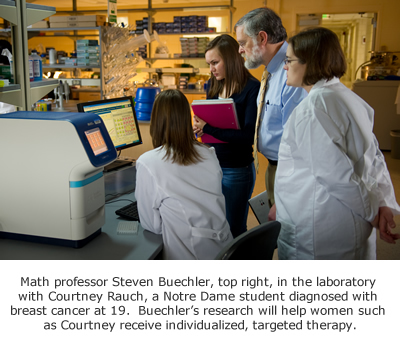Will help patients avoid unnecessary chemotherapy
Steven Buechler, chair of the Department of Applied and Computational Mathematics and Statistics, has developed a diagnostic test to help breast cancer patients decide whether to undergo chemotherapy treatment after surgery. Formation of a company to conduct large-scale trials and seek FDA approval could come later this year.
The test, conducted on part of the same tumor sample collected from a patient diagnosed with breast cancer, evaluates the expression levels of certain genes to gauge the likelihood that the cancer would metastasize without chemotherapy treatments. Avoiding unnecessary chemotherapy is desirable because the treatment has dangerous side effects, including heart disease and loss of hearing, as well as high costs and reduced quality of life. Unnecessary breast cancer treatments in the United States costs as much as $500 million a year.

The mathematician’s expertise is vital because of the complexity of the issue. “When you’re looking at these tumors and the molecular characteristics of them, the starting point for the analysis is measurements of the expression of every gene in the tumor sample,” Buechler says. “For each tumor you’ve got 50,000 measurements. When you look at populations of patients you’ve got 1,000 patients, 50,000 measurements for each one. It’s a massively complex collection of numbers. You overlay that with everything you know about the patients.”
Numbers generated by a chemical evaluation of the tissue are put into a software program that Buechler has written to produce a molecular profile and prognostic report. Data collected on breast cancer patients for more than a decade provides a baseline for predicting the chance that the patient will relapse based on the profile. Certain laboratories would be approved to conduct the analysis. “That report is sent back to the oncologist like all other reports,” he says. “The oncologist uses that information in discussion with the patient to decide a treatment.”
Buechler is working in collaboration with Dr. Sunil Badve, a pathologist at the Indiana University School of Medicine, with a grant from the Indiana Clinical and Translational Sciences Institute. Preliminary trials of the clinical version last year proved promising, and another round of tests on 100 samples will be conducted this spring.
“At that point, we’ll have a version where we can describe the protocol precisely as to how this will work,” Buechler says. “We’re very comfortable that the protocol that we’ve developed is going to work. What we’re doing now is working on a version of the test that uses technology that enables it to be offered in a way that minimizes possibilities of error. It’s very standardized and could be easily implemented in a pathology lab.”